Can Sonic become the next generation L1 and validate AC's previous sharp criticism that "L2 as application chains is illogical for developers"?
Written by: Sonic Labs
Translated by: Yangz, Techub News
Translator's Note: The L2 track is bustling, while L1 is relatively deserted. It has been a year since the Fantom Foundation announced the Sonic upgrade plan last October. Last week, Sonic Labs released the Litepaper, systematically showcasing the L1 blueprint of "DeFi King" Andre Cronje. Currently, there are only about two months left until the expected launch of the Sonic mainnet. Will Sonic be able to become the next generation L1 and validate AC's previous sharp criticism that "L2 as application chains is illogical for developers"? Let's wait and see!
The following is the full translation of the Sonic Litepaper.
Summary
In the ever-evolving blockchain ecosystem, what can truly make a network stand out? For Sonic, we believe the key lies in providing unique products and features that enable developers to build applications more competitively than developers on any other chain. Our focus is on providing tangible value to developers, increasing their revenue, allowing them to control network fee pricing, simplifying user payment methods, all of which can be completed in seconds.
Many existing platforms do not adequately meet developer-centric needs. Ethereum focuses on scalability through optimistic and zero-knowledge Rollups, with the current L2 TVL exceeding $34 billion. This shift towards L2 solutions inadvertently emphasizes extracting value through centralized orderers rather than promoting high-quality application development. The incentive structure aimed at increasing valuation and fees through Rollup deployment has commoditized L2 too much, prioritizing orderer revenue over security and decentralization. This trend has created an imbalance where orderers benefit excessively while developer compensation remains insufficient. Consequently, the adoption of innovative consumer applications has stagnated, limiting their potential to make a significant market impact.
Sonic was launched in recognition of these challenges; it is an L1 designed to redefine the developer incentive model. Sonic's fee monetization plan allows developers to earn up to 90% of the fees generated by their applications. With features like dynamic fees, fee subsidies, and native account abstraction, Sonic will provide flexible tools to enhance user experience and promote adoption.
Traditional L1s currently face a dilemma of either evolving or being eliminated, and Sonic is leading the transformation by offering unprecedented scalability, decentralization, and near-instant speed. Sonic combines the advantages of L1 and L2, providing 10,000 transactions per second, sub-second finality, and a native decentralized cross-chain bridge that connects Ethereum and enhances liquidity and security.
By combining cutting-edge technology with a developer-centric revolutionary model, Sonic aims to redefine the blockchain industry, revitalize the focus on consumer-facing productive applications, and empower builders to create profitable on-chain businesses.
Business Case and Initial Goals
As a decentralized L1, Sonic primarily offers distributed computing power supported by fees. The current anomalous incentive structure in the industry has marginalized basic productive applications and network revenue, shifting towards short-term parasitic and extractive monetization, leading to a decline in growth and momentum. Our measure of success is derived from a simple calculation: checking whether network revenue exceeds the total cost of incentivizing validators.
We create demand for these transactions by supporting developers and businesses in building consumer or B2B applications that need to write to the network and incur fees. Sonic's goal is to drive demand while utilizing the maximum transaction volume that the network can effectively provide without causing disruption, while charging enough fees per transaction to cover network costs.
Sonic can easily handle up to 900 million transactions daily, with TTF being sub-second. This supply capacity far exceeds current demand. Currently, all L2s combined process about 12 million transactions daily, peaking at around 17 million. Additionally, Solana's recent peak was 40 million transactions per day. Even if these peaks are combined, the total daily transaction volume is only about 57 million, just a small fraction of our threshold.
With abundant block space and transaction capacity, our focus shifts to expanding demand. To achieve more demand on a network than the entire industry currently processes, bold initiatives are required, such as:
- Fee Monetization (FeeM), rewarding builders with up to 90% of application fees
- Sonic Gateway, allowing users and builders to access Ethereum's liquidity through a secure native cross-chain bridge.
- One of the largest airdrop events in history, leveraging new users and new protocols to kickstart the network's flywheel effect.
- Dynamic fee features that allow developers to customize gas costs for interacting with their contracts, promoting an on-chain creator economy.
- Innovator Fund, allocating up to 200 million S tokens from the Sonic Labs treasury for acquiring infrastructure and strategic partners to promote the long-term development of the network.
- Sonic & Sodas, promoting community-driven developer-centric events funded by Sonic Labs around the world.
All of this will occur alongside the deployment of 3A-level infrastructure partners, including Chainlink, Pyth, Dune, Alchemy, Safe, and others.
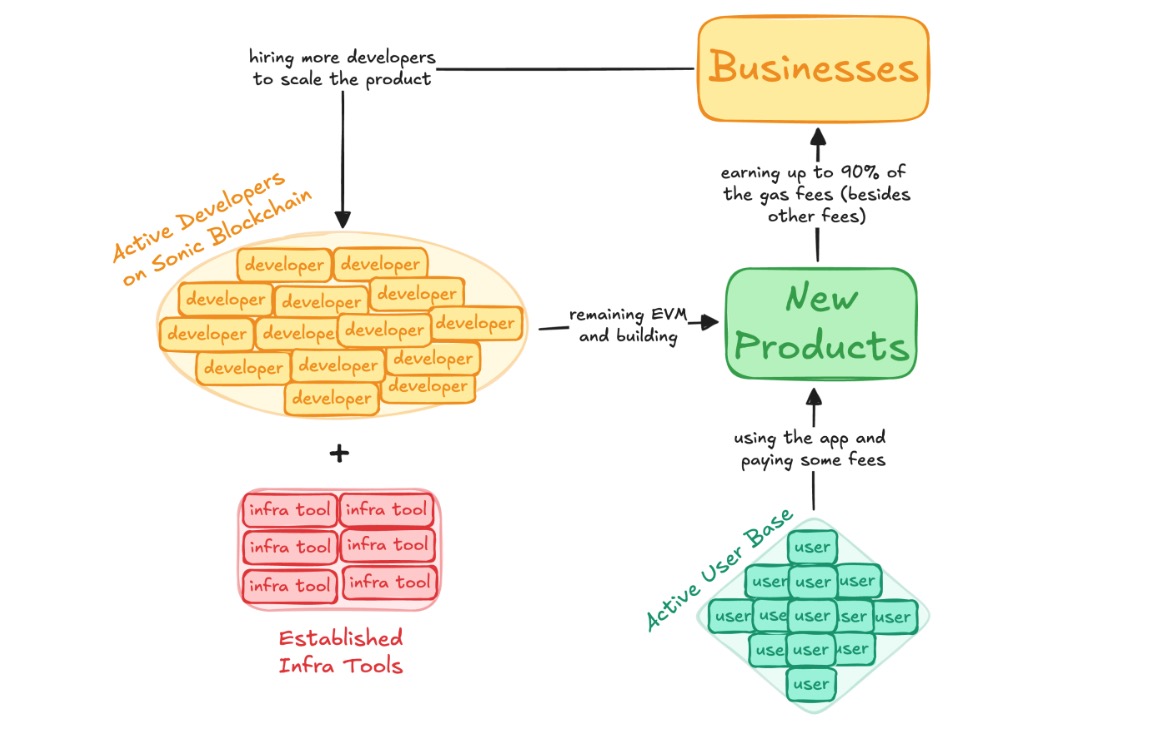
Incentive Mechanism
Peter Thiel invested heavily in user acquisition during PayPal's early stages, paying each user $10 for signing up and referring friends. Similarly, the Sonic Labs treasury will fund projects like the Innovator Program with up to 200 million S tokens to accelerate the immediate adoption of Sonic ecosystem applications and support new innovative enterprises. Additionally, airdrop activities involving 190.5 million S tokens will provide Sonic developers with opportunities to attract more users by incentivizing application usage. Furthermore, Sonic is rapidly simplifying its liquid staking token (LST) market, providing more flexibility for dedicated token holders.
Currently, a group of mature developers is ready to migrate from Fantom Opera to Sonic, but achieving the goal still requires millions of users and thousands of developers.
Sonic Labs Innovator Fund
The Sonic Labs Innovator Fund is directly funded from the Sonic Labs treasury, consisting of up to 200 million S tokens. This fund is currently being used to ensure Sonic's integration with top-tier infrastructure, ensuring builders can utilize outstanding tools in today's challenging market.
Sonic is actively collaborating with dozens of applications and top infrastructure providers in the industry, covering areas such as on-chain tools, compliance, native assets, real-world assets, cross-chain bridge integration, custody solutions, institutional adoption, exchange-traded products, wallets, Subgraph, strategic Web2 partnerships, and more. As of now, publicly disclosed secure infrastructure integrations include Chainlink, Dune, Safe, Pyth, Alchemy, Redstone, Tenderly, and others.
Airdrop Plan
We plan to airdrop 190.5 million S tokens to incentivize users and developers for their activities on Opera and the new Sonic chain.
The first major component of the airdrop plan is Sonic Boom, which will allocate Sonic Gems (points in the airdrop plan) to up to 30 winning projects as a reward for developing various innovative applications. This program helps create a DeFi ecosystem on Sonic and kickstarts the adoption flywheel. Project teams can distribute these points as rewards to users for using their applications, helping them maintain user engagement through incentivized usage.
Sonic aims to discover promising teams and provide them with the tools needed to create successful applications in DeFi, gaming, artificial intelligence, and other fields. The focus of the airdrop is to reach a critical mass within the developer community so that we can continue to support their growth as they scale their businesses.
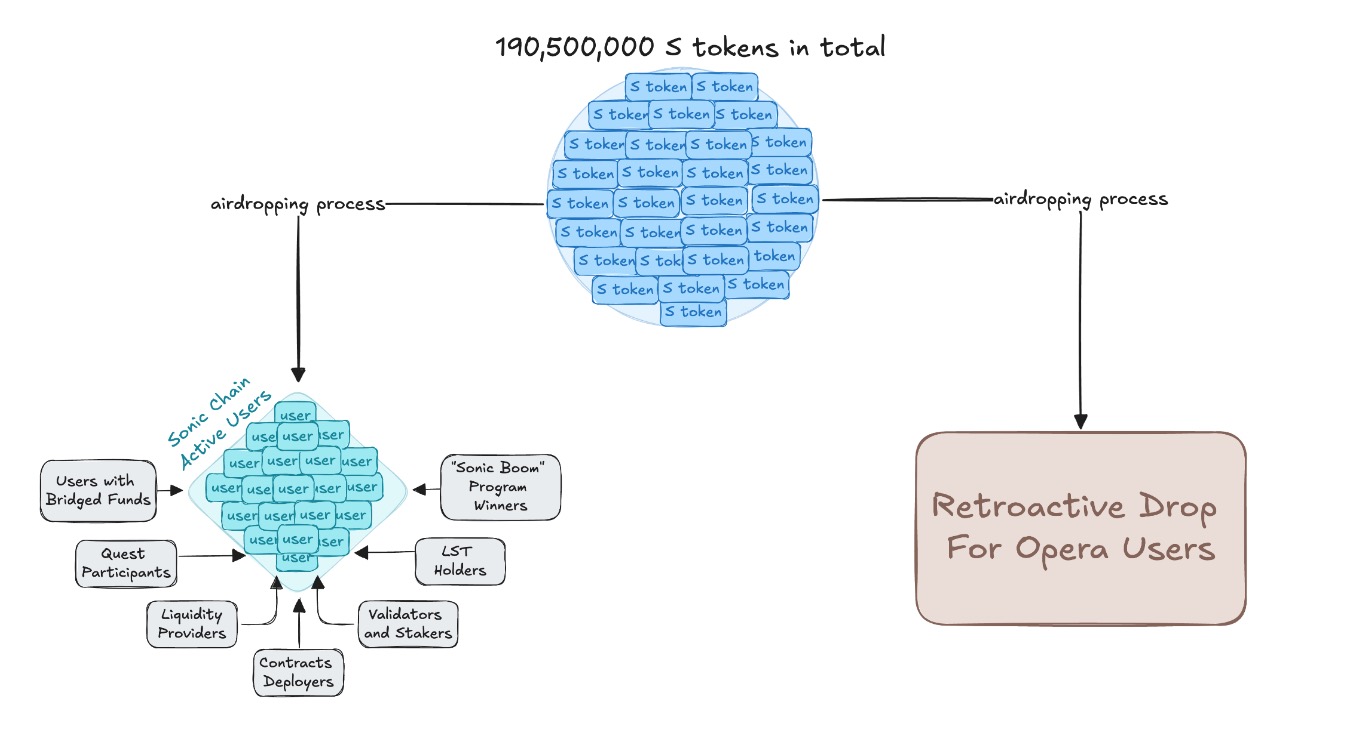
Airdrop Design
Sonic adopts a deflationary airdrop system, introducing game theory through a unique linear decay mechanism to address the challenging issue of active on-chain airdrop incentive mechanisms. Specifically, this type of airdrop aims to minimize sudden misalignments in circulating supply over a short period, and linear decay and destruction can solve this problem.
Specifically, the destruction mechanism encourages airdrop recipients to increase on-chain activity while waiting for their preferred exit destruction. Recipients can either wait for the complete unlocking of their airdrop positions or redeem early (but with some loss). As for those who do not choose either of the above options, their airdrop will be allocated to speculative buyers.
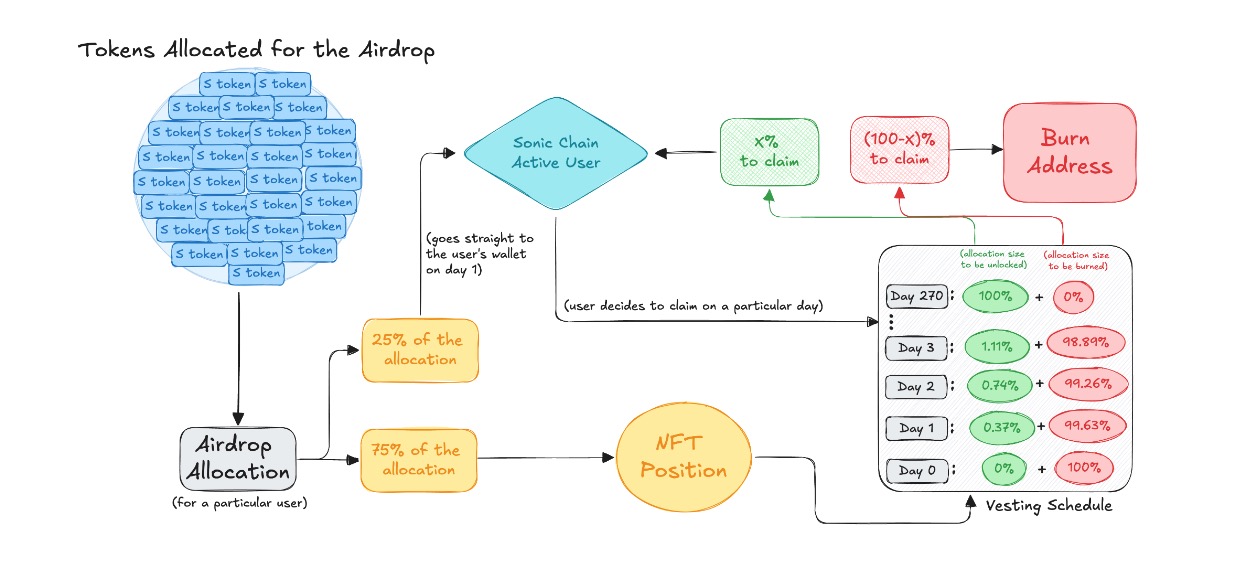
On the first day of the airdrop, 25% of the airdrop received by users will be liquid, while the remaining 75% will vest over 9 months (270 days) as ERC-1155 NFT positions. Sonic users can immediately claim this 25% allocation and flexibly decide when to claim the final allocation based on the corresponding consumption rate.
Users who choose to hold the NFT but wish to trade on the secondary market can freely trade, creating a speculative market for individual users' airdrop allocations while also exerting deflationary pressure on the airdrop. The following diagram illustrates the number of S tokens that will be confiscated by the destruction mechanism if users apply for withdrawal before the 270-day unlocking period.
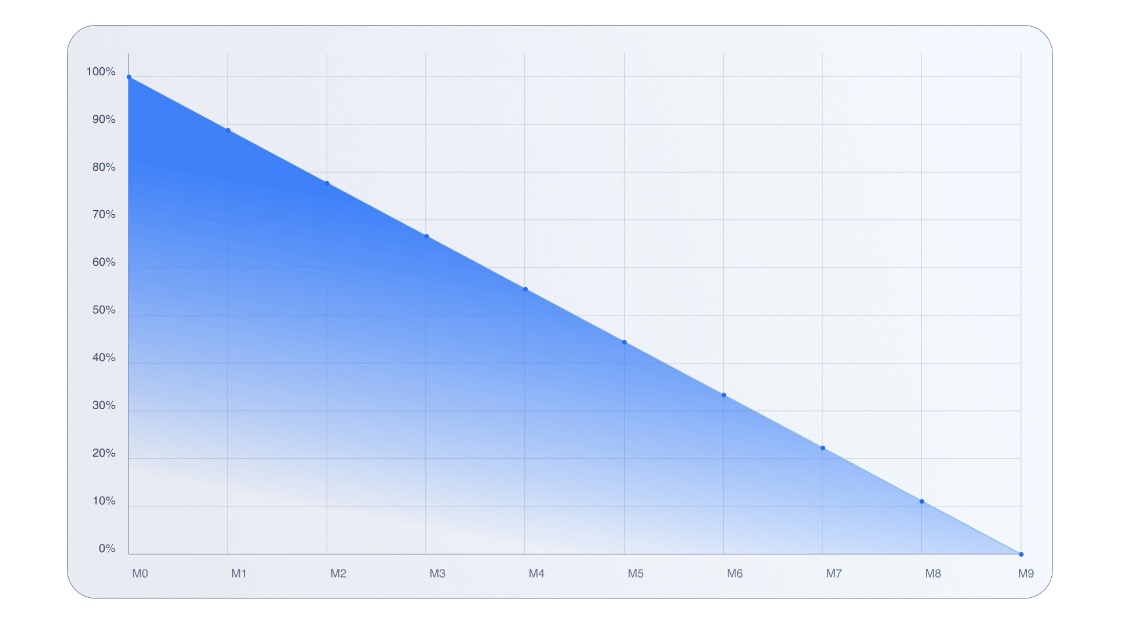
Fee Monetization
Sonic's fee monetization plan (formerly known as Gas monetization) will provide developers with up to 90% of the fees generated by their applications, offering them sustainable income to retain top creators and support network infrastructure.
Through fee monetization, Sonic aims to establish a thriving ecosystem for developers similar to the advertising revenue model on traditional network platforms. The breakdown of transaction fees is as follows, including an innovative destruction mechanism:
- Transactions on Non-Fee Monetization Applications
If a user submits a transaction on an application that does not participate in FeeM, 50% of the transaction fee will be burned, and the remaining amount will be allocated to validators and the ecosystem treasury.
- Transactions on Fee Monetization Applications
If a user submits a transaction on an application that participates in FeeM, 90% of the transaction fee will go to the application's developer, while the remaining portion will go to the validators.
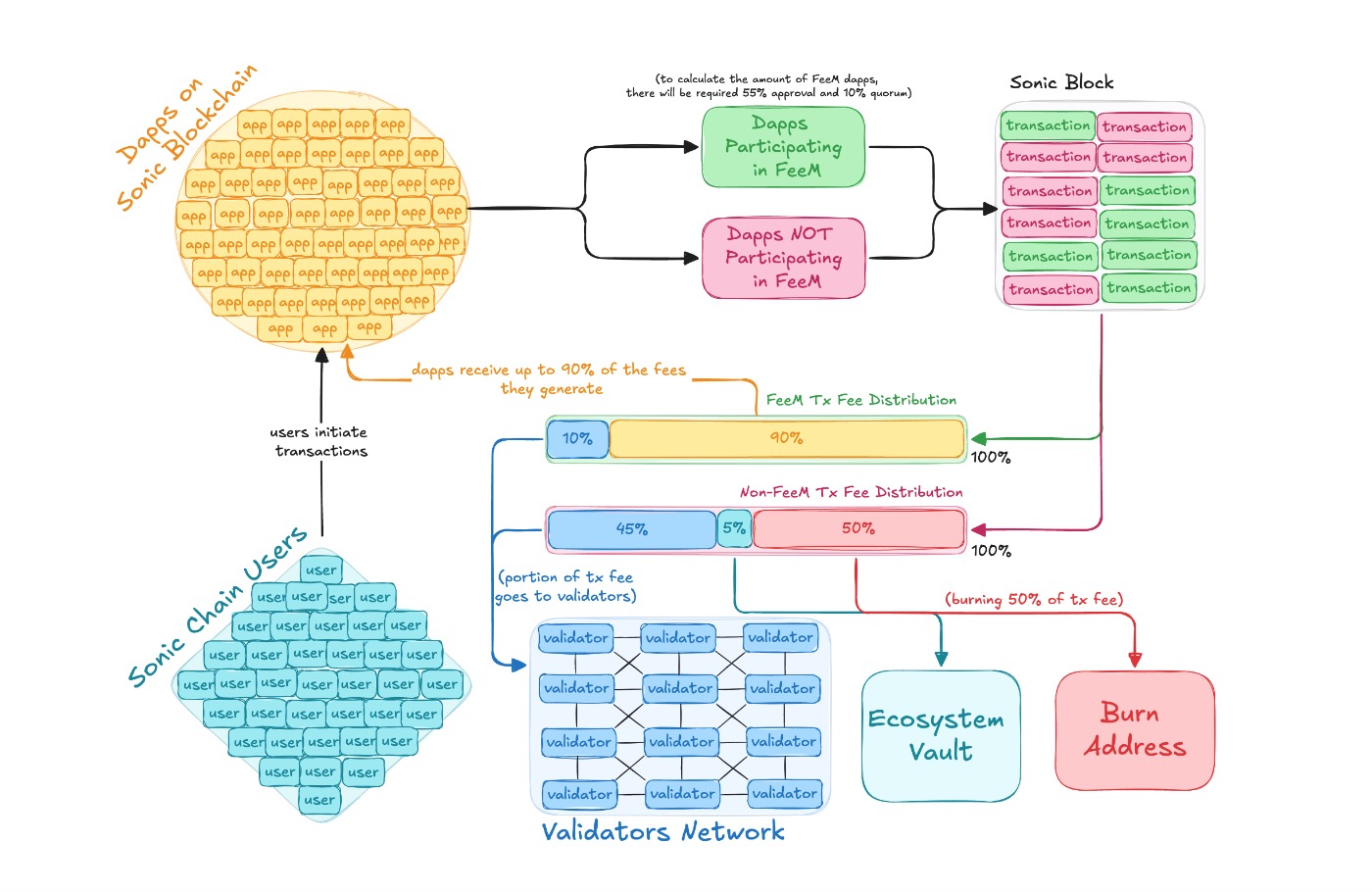
Fee Structure
Sonic's proposed target block reward rate of 3.5% ensures that the network can continue to support its applications. The table below outlines the differences in transaction fee distribution between applications that do not participate in FeeM and those that do.

If the transaction fees earned by applications participating in FeeM are below the 90% cap, the remaining transaction fees will be sent to the validators.
Destruction and FeeM Mechanism Example
- Scenario: 50% of transactions come from applications participating in FeeM, while the remaining 50% are non-FeeM transactions
- Average target cost: $0.01 per transaction
- Network capacity: Sonic can handle over 900 million transactions daily
- Forecast: Achieving 10 million transactions daily will result in:
- Approximately $100,000 in daily inflow
- Approximately $36.5 million in annual inflow
- $9.125 million burned annually
- $10.0375 million paid to validators annually
- $16.425 million paid to Sonic developers annually
Sonic Liquid Staking Token
During the operation of Fantom, there was a sustained staking node rate of over 40%, higher than Ethereum's approximately 30%. However, the complex staking mechanism hindered the prosperity of the LST market, limiting the influx of millions into the DeFi ecosystem.
Sonic's new staking mechanism will set a 14-day lock-up period and a 7-day withdrawal period, creating an ideal structure for utilizing an estimated LST market exceeding $500 million.
Technical Architecture
Sonic will provide developers with exceptional scalability and storage capacity while delivering a fast, seamless user experience. Sonic can perform up to 10,000 ERC-20 transfer transactions per second, with sub-second finality, enabling instant, irreversible transactions and efficient data management through cutting-edge storage systems.
Unlike L2 and Ethereum, true final transactions can be achieved in just one block (with no longest chain rule), and there is no need to package data and write it back to Ethereum.
Sonic Gateway
In the evolving blockchain ecosystem, a native, decentralized cross-chain bridge is crucial for a healthy ecosystem, enabling strong interoperability and preventing network isolation. However, current L1 and L2 solutions often force users to compromise on security, speed, and decentralization. Currently, cross-chain bridge hacks have resulted in losses exceeding $2.5 billion.
Recognizing these systemic threats, Sonic's cross-chain bridge has established the following simple goals:
- Security: Ensure safety through built-in fail-safe mechanisms.
- Speed: Provide a smooth user experience for easy asset cross-chain transfers.
- Decentralization: Eliminate single points of control, ensuring only users can access their funds.
Sonic Gateway is a trustless cross-chain bridge that facilitates ERC-20 token transfers between Ethereum and Sonic while achieving the above three points simultaneously. By leveraging Sonic's own validator network (validators operate nodes on both chains), Sonic Gateway establishes a secure decentralized channel between the two platforms.
With built-in fail-safe mechanisms, Sonic Gateway provides asset security guarantees, protecting users' funds under any circumstances. Most importantly, only users can access funds transferred through Sonic Gateway; no centralized entity can override user control or access funds through a master key.
Additionally, Sonic Gateway is designed for efficiency. Transfers from Ethereum to Sonic take a maximum of 10 minutes, while transfers from Sonic to Ethereum take a maximum of 1 hour (these intervals are referred to as "heartbeats"). Although Sonic is not an L2, it will still be an active participant in the Ethereum ecosystem, as Sonic will spend ETH to write transactions onto the chain through Sonic Gateway.
Fast-Lane Transactions (Fast-Lane TX)
Users can choose to execute transactions immediately using "Fast-Lane Transactions." By paying to bypass the standard "heartbeats" (which typically delay the availability of funds on the target chain), users can access their funds instantly.
Fast-Lane Transactions transfer the entire state to the target chain, just like regular "heartbeats" transactions, benefiting all users, not just those submitting transactions. Essentially, it is equivalent to a "heartbeats" transaction, but submitted earlier. Importantly, Fast-Lane Transactions are added as an enhancement and do not alter the standard "heartbeats" timing.
For example, if the standard "heartbeats" interval from Ethereum to Sonic is 10 minutes, submitting a Fast-Lane Transaction 5 minutes before the next scheduled "heartbeats" allows all users transferring from Ethereum to Sonic to access their funds immediately, while the next standard "heartbeats" interval remains 5 minutes.
Gateway Fail-Safe Mechanism
Sonic Gateway has a built-in fail-safe mechanism that allows users to retrieve their cross-chain assets on the original chain in the event of a failure of Sonic or its gateway.
This fail-safe mechanism activates after the gateway has failed continuously for 14 days, providing users with assurance for transferring assets from Ethereum to Sonic. As a form of insurance, the 14-day fail-safe period is immutable, meaning that once Sonic Gateway is deployed, Sonic Labs or any other third-party entity cannot change it.
Importantly, this period is not a competitive window but a fundamental function to ensure users retain custody of their cross-chain funds on the original chain.
How the Fail-Safe Mechanism Works
Sonic Gateway transmits "heartbeats" between chains, which include the Merkle root and block height of each blockchain. If the "heartbeats" stop for 14 days, a signal of Gateway failure is issued, allowing users' funds to be unlocked on Ethereum.

Of course, only assets transferred through Sonic Gateway can be recovered. The 14-day duration serves as a buffer period to resolve any issues before the Gateway is deemed unavailable.
Sonic vs. L2
Most L2s are optimistic Rollups, which operate under the assumption that all withdrawals are valid unless challenged (hence the term "optimistic"). To ensure security, these L2s have a 7-day challenge period that allows anyone to verify and contest withdrawal claims on Ethereum. For example, if you want to transfer 2 ETH from Optimism to any other platform, those assets will not be released on Ethereum until the 7-day challenge period ends. So why does it only take a few minutes to transfer from platforms like Arbitrum and Optimism to exchanges like Binance?
In reality, while the transfer from optimistic Rollup to exchanges like Binance may seem quick, the exchange assumes the risk associated with the challenge period; this is because Binance trusts most L2s. However, until the 7-day challenge window closes, the funds deposited into your account by the exchange are technically not secure, meaning the exchange bears the risk during this period.
In contrast, Sonic, as an L1, has its own security validators that can provide exchanges with instant (single block) transfers without associated risks, as these transactions are not subject to any challenge period, and the same applies if USDC (and other ERC-20 tokens) become native tokens on Sonic. Additionally, assets cross-chain from Ethereum through Sonic Gateway will be completed within an hour, making it a faster and safer alternative compared to the 7-day challenge period required by most L2 solutions.
Sonic Database
Sonic uses a database to store its world state, including account information, virtual machine bytecode, smart contract storage, and more. This database features a function called "live pruning," which automatically deletes historical data, thereby reducing storage requirements for validators.
Previously, pruning required validator nodes to be offline, which posed financial and operational risks. Now, validators can perform real-time pruning, saving disk space and costs while ensuring continuous operation by discarding historical data in real-time.
The way live pruning works is by dividing the database into two types: LiveDB and ArchiveDB. LiveDB contains only the current block's world state, while ArchiveDB contains the world state of all historical blocks. Validators only use LiveDB, while archive nodes have both LiveDB and ArchiveDB to handle historical data requests via RPC interfaces.
Sonic's database storage employs an efficient tree or hierarchical structure, simplifying data retrieval. Importantly, it still provides cryptographic signatures for the world state and offers archiving capabilities using an incremental version of the prefix algorithm. Additionally, it utilizes a local disk format rather than indirectly storing the world state through key-value stores like LevelDB or PebbleDB.
Sonic Virtual Machine
Sonic Virtual Machine (VM) will replace EVM and enhance Sonic's execution speed. The Sonic Virtual Machine will be fully compatible with Solidity and Vyper, allowing ecosystem developers to continue using the same development tools. Additionally, Sonic will support Geth 1.4.
Token Economics
Sonic's native token is S, which serves multiple purposes:
- Payment of transaction fees
- Ensuring chain security through staking (minimum of 1 S)
- Running validators to ensure chain security (at least 50,000 S)
Participation in Governance
At the launch of the Sonic mainnet, the total supply of S will be 3.175 billion, corresponding to the total supply of FTM, and the circulating supply of S will correspond to the circulating supply of FTM at that time. Users holding FTM can exchange it for S at a 1:1 ratio. Based on decisions from multiple governance proposals, the following additions will be gradually implemented into the token economics of S.
Airdrop Plan
Six months after the launch of Sonic, 6% of the newly minted 3.175 billion S tokens will be allocated for an airdrop plan, rewarding users and builders of Fantom Opera and Sonic. The airdrop plan will adopt an innovative burn mechanism to reward actively participating users and gradually reduce the total supply of S tokens.
Continuous Grants
Six months after the launch of Sonic, more S tokens will be minted to increase the adoption and global impact of S; to grow the team and expand operations to enhance adoption; to implement strong marketing initiatives and DeFi activities; and to launch the Sonic Spark and Sonic University programs to drive the future development of Sonic.
To fund this plan, starting six months after the mainnet launch, an additional 1.5% of the initial total supply of S tokens (equivalent to 47.625 million) will be minted annually for six years. However, to prevent inflation, Sonic will burn any newly minted tokens that are not used in that year, ensuring that all newly minted tokens from this initiative are 100% used for network growth rather than held in the treasury for future use. For example, if Sonic Labs only uses 5 million tokens in the first year, the remaining 42.625 million tokens will be burned.
Block Rewards
We are migrating validator rewards from Fantom Opera to Sonic. In the initial years, Opera validators will continue to receive rewards. However, as validators and stakers transition to Sonic, we will reduce their block rewards. The funds saved from reducing rewards will be reallocated to reward Sonic validators. Meanwhile, the Sonic Foundation will continue to maintain Opera validators for the foreseeable future.
Sonic's target annual percentage rate (APR) is 3.5%. To maintain this yield without causing inflation in the first four years, we will reallocate the remaining FTM block rewards from Opera to Sonic as rewards for validators and stakers. These rewards are already included in the initial supply of 3.175 billion S tokens.
Although technically, the initial total supply of S tokens is 3.175 billion, consistent with the total supply of FTM, the circulating supply at launch will be approximately 2,883,358,939 tokens. The difference (70,067,224 tokens per year) will be distributed as rewards to validators in Sonic's first four years. During this period, we can avoid minting new S tokens for block rewards.
Due to these changes, the annual interest rate for Opera will drop to zero after the launch of Sonic. Additionally, to preserve value for all FTM and S token holders and eliminate the demand for new inflationary rewards at the beginning of Sonic's launch, we will not mint new tokens for validator security in the first four years of Sonic's deployment. After four years, S block rewards will continue to mint new tokens at a rate of 1.75% per year to reward validators.
The following chart shows the total issuance of S tokens in the first 7 years.
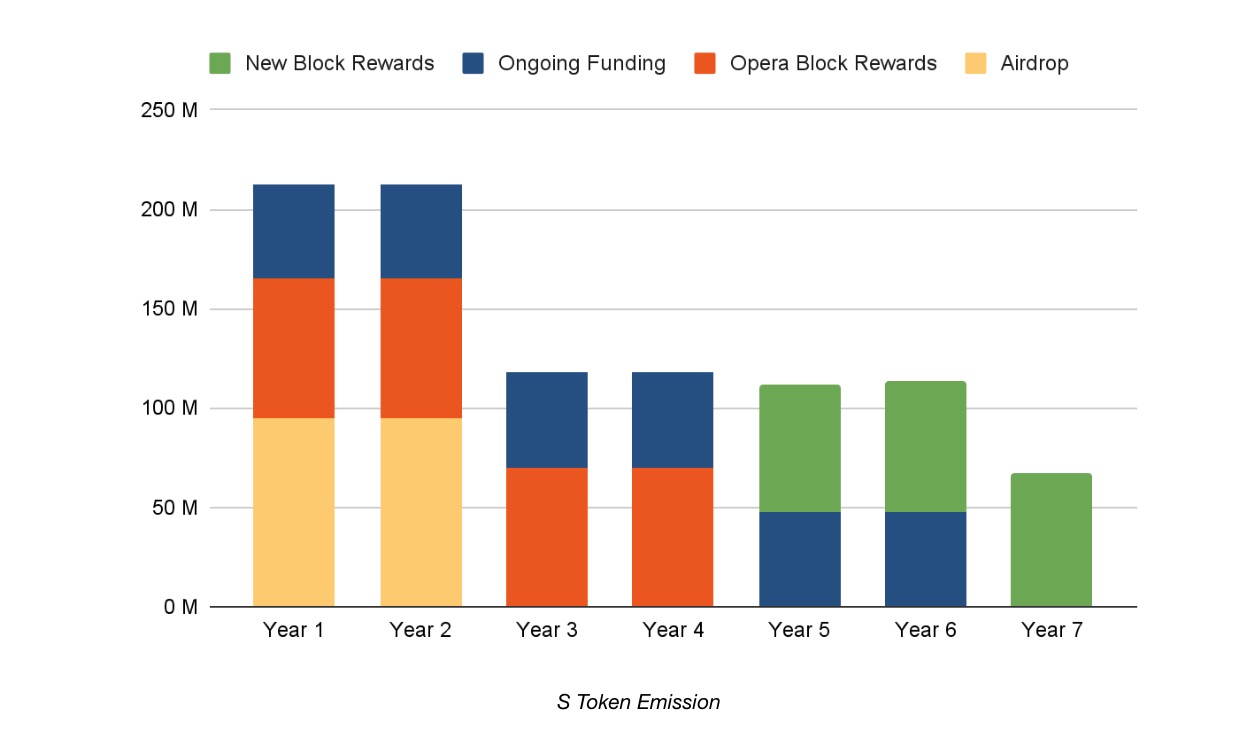
Token Burn Mechanism
Sonic has three burn mechanisms to reduce the release of new S tokens:
- Fee monetization burn mechanism: If a user submits a transaction on an application that does not participate in FeeM, 50% of the transaction fee will be burned.
- Airdrop burn mechanism: If a user does not choose to wait for 75% of the airdrop to unlock during the 270-day unlocking period, they will lose a portion of their S tokens, which will be burned.
- Burn mechanism in continuous grants: In the first six years of Sonic, 47.625 million S tokens will be minted annually to fund growth, and any unused tokens from that year will be burned.
The following chart predicts the circulating supply of S from launch to year 7. The blue line represents the circulating supply without any burns, while the red line represents the supply with burns included.
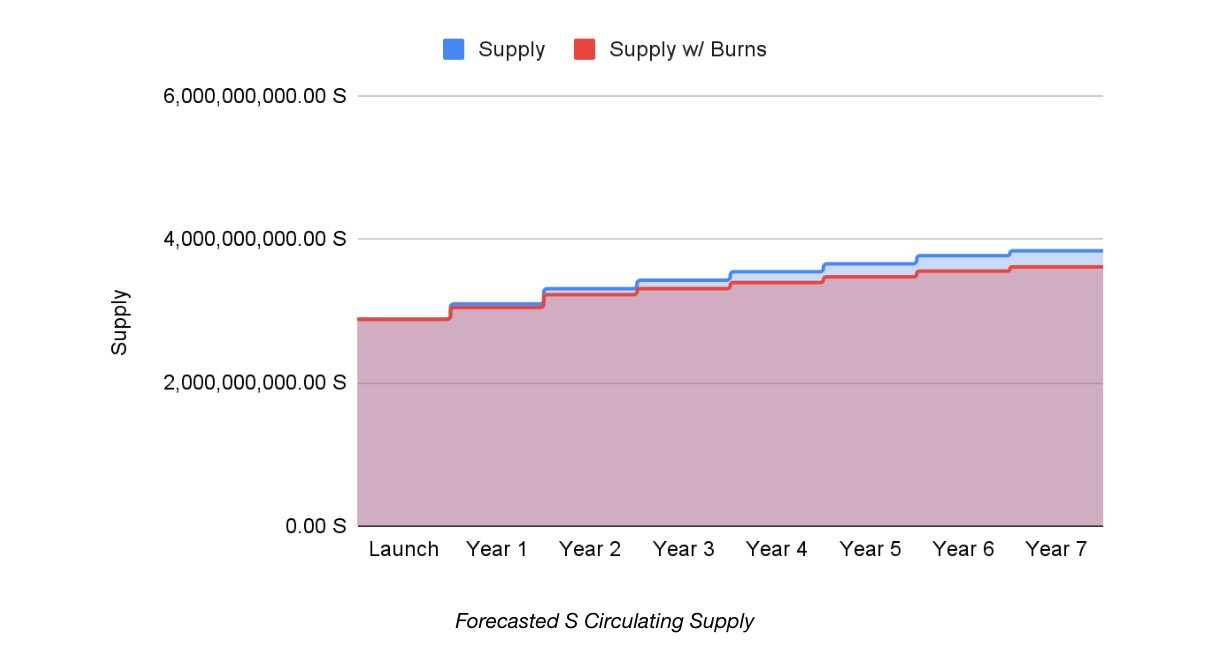
To display the potential burn amount in the above chart, we assume that 50% of the S tokens from continuous grants will be burned. Additionally, we assume that there are 10 million transactions daily on Sonic, with an average transaction fee of approximately $0.01, and that half of these transactions occur on non-FeeM applications, where 50% of the fees will be burned. Finally, we assume that users will consume an average of 20% of the airdrop, as some will choose to claim early.
Please note that the provided token economics calculations assume Sonic launches in December 2024. If the launch date changes, the token economics will be adjusted accordingly.
From Fantom to Sonic
After extensive discussions within the Fantom community and through four governance votes (results shown below), Sonic will serve as the new chain, representing Fantom's continued progress.

FTM holders can exchange S through one of the following two methods:
- Centralized exchanges: Sonic is working with most exchanges currently listing FTM to coordinate automatic exchanges for users.
- Self-custody/DeFi users: Sonic Labs will launch a simple bridge to facilitate a 1:1 exchange from FTM to S. Bi-directional exchanges will be supported for the first 90 days after the launch of the Sonic mainnet. After 90 days, starting from 4 PM GMT on the 91st day, only one-way exchanges from FTM to S will be allowed.
Conclusion
Sonic aims to revolutionize the blockchain industry by providing a next-generation L1 that integrates speed, scalability, and security. By introducing innovative features such as fee monetization, a secure cross-chain bridge that connects to Ethereum, and a simplified staking mechanism, Sonic positions itself as a developer-friendly platform that prioritizes builders and users.
免责声明:本文章仅代表作者个人观点,不代表本平台的立场和观点。本文章仅供信息分享,不构成对任何人的任何投资建议。用户与作者之间的任何争议,与本平台无关。如网页中刊载的文章或图片涉及侵权,请提供相关的权利证明和身份证明发送邮件到support@aicoin.com,本平台相关工作人员将会进行核查。




